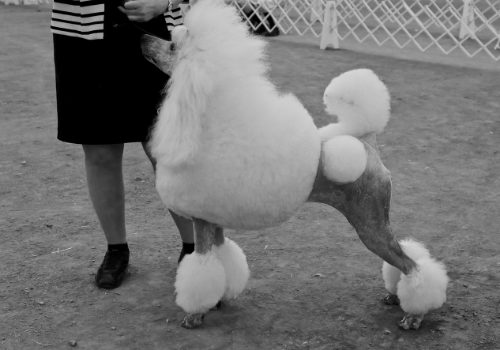When it comes to poodle tails, there is a controversial practice that has been performed for many years: docking. Docking refers to the removal of a portion of a poodle’s tail, usually done shortly after birth. This practice has sparked debates among dog owners, veterinarians, and animal welfare organizations. But what are the reasons behind poodle tail docking, and is it truly necessary or humane?
Poodle tail docking has a long history that dates back to the 18th century. Originally, the purpose of docking was to prevent injury to hunting and working dogs, as well as to enhance their agility in the field. However, in modern times, docking is mostly done for cosmetic reasons, to conform to breed standards. While some argue that trimming the tail is a painless procedure that doesn’t impact the dog’s overall well-being, others believe it is an unnecessary and potentially harmful practice.
Poodle tails are often docked when they are puppies. This is typically done by a veterinarian and involves the removal of a portion of the tail. The main reason for docking poodle tails is for aesthetic purposes, as it is a traditional practice in the breed standard. However, tail docking is a controversial topic, and some countries have banned the practice. If you are considering getting a poodle, it’s important to research and understand the different viewpoints on tail docking.

The Controversy Surrounding Poodle Tail Docking
Poodle tail docking is a practice that has sparked controversy among dog owners and animal welfare advocates. The act of docking involves removing a portion of the tail of a poodle, usually when they are just a few days old. But is this procedure necessary or ethical? Let’s explore the different perspectives and considerations surrounding poodle tail docking.
It’s important to note that tail docking is not exclusive to poodles. Many dog breeds, particularly those historically used for working or hunting purposes, have had their tails docked for various reasons. However, poodles are often associated with this practice due to their distinct appearance and popularity as companion pets.
There are several reasons why poodle tails have been traditionally docked. One reason is to prevent injury. Poodles, with their long, hairy tails, are prone to accidents where their tails may become tangled or caught in objects. Docking the tail reduces the risk of these incidents, potentially saving the poodle from pain and suffering.
The Aesthetic and Breed Standard Argument
Another argument in favor of poodle tail docking relates to aesthetics and breed standards. Poodles are known for their distinctive appearance, which includes a specific tail carriage. Docking the tail helps to achieve this desired look, ensuring that poodles conform to the breed standard set by kennel clubs and dog shows.
Proponents argue that tail docking enhances the poodle’s overall appearance, creating a balanced and elegant silhouette. It is believed that a docked tail contributes to the breed’s unique poise and movement. Additionally, docking is thought to accentuate the poodle’s characteristic high-stepping gait.
For those involved in competitive dog shows, adhering to breed standards is crucial. Poodles with docked tails are more likely to be recognized and awarded top honors. Thus, tail docking continues to be practiced to maintain the breed’s competitive advantage in show rings.
The Ethical Concerns and Opposition to Docking
On the other side of the argument, many animal welfare advocates and organizations oppose poodle tail docking. Their primary concern is the welfare of the dogs. Critics argue that docking a dog’s tail is an unnecessary and painful procedure that deprives them of a natural appendage that serves important functions.
The tail is essential for balance, communication, and expression in dogs. It helps them with body language communication and serves as a means of expressing their emotions. By removing a portion of the tail, poodles are deprived of these vital means of communication, potentially leading to behavioral and emotional issues.
The docking process itself can cause pain and discomfort for the young puppies. The puppies must undergo the procedure without any form of anesthesia, making it a traumatic experience. Animal welfare advocates argue that subjecting animals to unnecessary surgery and pain for purely cosmetic purposes is unjustifiable.
The Legal Landscape and Changing Perceptions
The legality of poodle tail docking varies by country and jurisdiction. In some places, the practice is still legally allowed, especially for certain working dog breeds. However, in many countries, tail docking is considered illegal unless there is a legitimate medical reason.
Public opinion and awareness regarding animal welfare have also played a significant role in shifting perceptions towards poodle tail docking. There is a growing understanding and concern for the well-being and natural rights of animals. As a result, more people are advocating for the end of tail docking, seeing it as an outdated and unnecessary practice.
Some kennel clubs and dog show organizations have also revised their breed standards to discourage or outright ban tail docking. These changes reflect a more modern and humane approach to dog breeding and showing, prioritizing the overall welfare and natural attributes of the animals.
The Future of Poodle Tail Docking
The controversy surrounding poodle tail docking continues to spark discussions and debates among experts, breeders, and dog lovers. While there are valid arguments for and against the practice, it seems that the tide is turning towards ending the procedure altogether.
As laws change and societal attitudes towards animal welfare evolve, poodle tail docking may become less common. Breeders, owners, and enthusiasts have the power to shape the future of the practice by prioritizing the health, happiness, and well-being of the poodles over conformity to outdated aesthetic standards.
Ultimately, the decision to dock a poodle’s tail rests with individual breeders and owners. It is important to weigh the potential risks, benefits, and ethical considerations before choosing to undertake the procedure. Consulting with veterinarians and understanding both sides of the argument can help make an informed decision and contribute to the well-being of these beloved dogs.
Further Research and Resources
For more information on poodle tail docking and the ethical considerations surrounding the practice, you can refer to the following resources:
- ASPCA: Tail Docking FAQs
- The Humane Society of the United States: Position Statement on Tail Docking
- World Small Animal Veterinary Association: Welfare Implications of Tail Docking Dogs
- Fédération Cynologique Internationale: Policy on tail docking
Key Takeaways: Are Poodle Tails Docked?
- Docking is the practice of surgically removing part of a dog’s tail.
- Poodles historically had their tails docked for practical and aesthetic reasons.
- Today, docking poodle tails is mostly done for cosmetic purposes.
- Docking is controversial and is banned or regulated in some countries.
- There are non-docked poodles with naturally long tails.
Frequently Asked Questions
In this section, we will answer some commonly asked questions about the docking of poodle tails.
1. When are poodle tails docked?
Poodle tails are typically docked within a few days after birth. This is a common practice among certain breeds, including poodles, and is usually done for aesthetic purposes. The exact timing of the procedure may vary based on the specific breeder and their preferences.
Docking involves removing a portion of the tail, usually by a veterinarian, using a surgical procedure. It is important to note that tail docking is a controversial practice, and laws and regulations regarding the procedure may vary in different countries or regions.
2. Why are poodle tails docked?
The main reason why poodle tails are docked is for cosmetic purposes. The tradition of docking poodle tails dates back to the breed’s origins as a hunting and working dog. The shortened tail was believed to prevent injuries and make it easier for the poodle to retrieve game from the water.
However, in modern times, the primary motivation for tail docking is to conform to breed standards and give poodles their distinct appearance. There are discussions surrounding the ethics of cosmetic tail docking, and some countries have even banned the practice.
3. Is tail docking painful for poodles?
Tail docking can cause discomfort and pain for poodles, as it involves a surgical procedure. The tail is a sensitive part of the dog’s body, and the removal of a portion of it can be painful during the healing process. Local anesthesia is often used to minimize the pain during the procedure.
It is essential to ensure that the procedure is performed by a licensed veterinarian who follows proper protocols and provides appropriate pain management to minimize the discomfort experienced by the poodle.
4. Are there any health risks associated with tail docking?
There can be potential health risks associated with tail docking. The surgical procedure carries the risk of infection, bleeding, and complications during healing. Additionally, docking the tail can disrupt the natural balance and communication of the dog’s body, which may have long-term effects on their overall well-being.
It is crucial to discuss the potential risks and benefits of tail docking with a veterinarian to make an informed decision based on the individual dog’s health and breed standards.
5. Is tail docking legal in all countries?
The legality of tail docking varies between countries and regions. Some countries, such as Australia, New Zealand, and parts of Europe, have banned the practice except for medical reasons. Other countries, like the United States, allow tail docking for certain breeds, including poodles, but have regulations and guidelines surrounding the procedure.
It is important to familiarize yourself with the laws and regulations in your specific location to ensure compliance and make informed decisions regarding tail docking.

Poodle Tails – Docked or Natural? – Petdii.com
In summary, poodle tails are often docked for aesthetic purposes, but this practice is controversial and not always necessary for the dog’s well-being.
While some argue that docking prevents certain health issues, there is limited scientific evidence to support this claim. It is important for prospective poodle owners to research and consider the potential consequences before seeking a docked tail.
